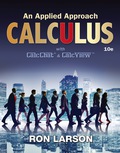
EBK CALCULUS: AN APPLIED APPROACH
10th Edition
ISBN: 8220101426222
Author: Larson
Publisher: CENGAGE L
expand_more
expand_more
format_list_bulleted
Concept explainers
Question
Chapter A3, Problem 57E
To determine
To calculate: The period T(in second) of a pendulum is
Length (in feet) of pendulum.
Expert Solution & Answer
Want to see the full answer?
Check out a sample textbook solution
Students have asked these similar questions
Find the indefinite integral.
Check
Answer:
7x
4 + 1x
dx
show sketch
Find the indefinite integral.
Check
Answer:
7x
4 + 1x
dx
Chapter A3 Solutions
EBK CALCULUS: AN APPLIED APPROACH
Ch. A3 - Checkpoint 1 Worked-out solution available at...Ch. A3 - Prob. 2CPCh. A3 - Prob. 3CPCh. A3 - Prob. 4CPCh. A3 - Prob. 5CPCh. A3 - Prob. 6CPCh. A3 - Prob. 7CPCh. A3 - Prob. 1ECh. A3 - Prob. 2ECh. A3 - Prob. 3E
Ch. A3 - Prob. 4ECh. A3 - Prob. 5ECh. A3 - Prob. 6ECh. A3 - Prob. 7ECh. A3 - Prob. 8ECh. A3 - Prob. 9ECh. A3 - Prob. 10ECh. A3 - Prob. 11ECh. A3 - Prob. 12ECh. A3 - Prob. 13ECh. A3 - Prob. 14ECh. A3 - Prob. 15ECh. A3 - Prob. 16ECh. A3 - Prob. 17ECh. A3 - Evaluating Expressions In Exercises 1-20, evaluate...Ch. A3 - Prob. 19ECh. A3 - Prob. 20ECh. A3 - Prob. 21ECh. A3 - Prob. 22ECh. A3 - Prob. 23ECh. A3 - Prob. 24ECh. A3 - Simplifying Expressions with Exponents In...Ch. A3 - Prob. 26ECh. A3 - Prob. 27ECh. A3 - Prob. 28ECh. A3 - Prob. 29ECh. A3 - Prob. 30ECh. A3 - Prob. 31ECh. A3 - Prob. 32ECh. A3 - Prob. 33ECh. A3 - Prob. 34ECh. A3 - Prob. 35ECh. A3 - Prob. 36ECh. A3 - Prob. 37ECh. A3 - Prob. 38ECh. A3 - Prob. 39ECh. A3 - Prob. 40ECh. A3 - Prob. 41ECh. A3 - Prob. 42ECh. A3 - Prob. 43ECh. A3 - Prob. 44ECh. A3 - Prob. 45ECh. A3 - Prob. 46ECh. A3 - Prob. 47ECh. A3 - Prob. 48ECh. A3 - Prob. 49ECh. A3 - Prob. 50ECh. A3 - Prob. 51ECh. A3 - Prob. 52ECh. A3 - Prob. 53ECh. A3 - Prob. 54ECh. A3 - Prob. 55ECh. A3 - Prob. 56ECh. A3 - Prob. 57ECh. A3 - Prob. 58E
Knowledge Booster
Learn more about
Need a deep-dive on the concept behind this application? Look no further. Learn more about this topic, calculus and related others by exploring similar questions and additional content below.Similar questions
- Here is a region R in Quadrant I. y 2.0 T 1.5 1.0 0.5 0.0 + 55 0.0 0.5 1.0 1.5 2.0 X It is bounded by y = x¹/3, y = 1, and x = 0. We want to evaluate this double integral. ONLY ONE order of integration will work. Good luck! The dA =???arrow_forward43–46. Directions of change Consider the following functions f and points P. Sketch the xy-plane showing P and the level curve through P. Indicate (as in Figure 15.52) the directions of maximum increase, maximum decrease, and no change for f. ■ 45. f(x, y) = x² + xy + y² + 7; P(−3, 3)arrow_forwardEX-let d'be ametric on a vector space X induced from a norm hx and d defind by a Slab)= {od (a, if a = b (a,b)+is ab Show that cannot be induced froman norm on X. 2) let à be trivel metric show that I cannot be induced from an norm on X- 3) let M be closed subspace of anormed spacex Construct the space X/Mas a normed space. 4) let Mix be vector space of 2x3 matrices on R write with Prove convex set and hyper Plane of M 5) show that every a finite dimension subspace of anormed space is closed.arrow_forward
- please do #48arrow_forward43–46. Directions of change Consider the following functions f and points P. Sketch the xy-plane showing P and the level curve through P. Indicate (as in Figure 15.52) the directions of maximum increase, maximum decrease, and no change for f. ■ 45. f(x, y) = x² + xy + y² + 7; P(−3, 3)arrow_forwardplese do #48arrow_forward
arrow_back_ios
SEE MORE QUESTIONS
arrow_forward_ios
Recommended textbooks for you
- Algebra & Trigonometry with Analytic GeometryAlgebraISBN:9781133382119Author:SwokowskiPublisher:Cengage
 Mathematics For Machine TechnologyAdvanced MathISBN:9781337798310Author:Peterson, John.Publisher:Cengage Learning,
Mathematics For Machine TechnologyAdvanced MathISBN:9781337798310Author:Peterson, John.Publisher:Cengage Learning, Algebra: Structure And Method, Book 1AlgebraISBN:9780395977224Author:Richard G. Brown, Mary P. Dolciani, Robert H. Sorgenfrey, William L. ColePublisher:McDougal Littell
Algebra: Structure And Method, Book 1AlgebraISBN:9780395977224Author:Richard G. Brown, Mary P. Dolciani, Robert H. Sorgenfrey, William L. ColePublisher:McDougal Littell  Trigonometry (MindTap Course List)TrigonometryISBN:9781305652224Author:Charles P. McKeague, Mark D. TurnerPublisher:Cengage Learning
Trigonometry (MindTap Course List)TrigonometryISBN:9781305652224Author:Charles P. McKeague, Mark D. TurnerPublisher:Cengage Learning Holt Mcdougal Larson Pre-algebra: Student Edition...AlgebraISBN:9780547587776Author:HOLT MCDOUGALPublisher:HOLT MCDOUGAL
Holt Mcdougal Larson Pre-algebra: Student Edition...AlgebraISBN:9780547587776Author:HOLT MCDOUGALPublisher:HOLT MCDOUGAL

Algebra & Trigonometry with Analytic Geometry
Algebra
ISBN:9781133382119
Author:Swokowski
Publisher:Cengage

Mathematics For Machine Technology
Advanced Math
ISBN:9781337798310
Author:Peterson, John.
Publisher:Cengage Learning,

Algebra: Structure And Method, Book 1
Algebra
ISBN:9780395977224
Author:Richard G. Brown, Mary P. Dolciani, Robert H. Sorgenfrey, William L. Cole
Publisher:McDougal Littell

Trigonometry (MindTap Course List)
Trigonometry
ISBN:9781305652224
Author:Charles P. McKeague, Mark D. Turner
Publisher:Cengage Learning

Holt Mcdougal Larson Pre-algebra: Student Edition...
Algebra
ISBN:9780547587776
Author:HOLT MCDOUGAL
Publisher:HOLT MCDOUGAL
Use of ALGEBRA in REAL LIFE; Author: Fast and Easy Maths !;https://www.youtube.com/watch?v=9_PbWFpvkDc;License: Standard YouTube License, CC-BY
Compound Interest Formula Explained, Investment, Monthly & Continuously, Word Problems, Algebra; Author: The Organic Chemistry Tutor;https://www.youtube.com/watch?v=P182Abv3fOk;License: Standard YouTube License, CC-BY
Applications of Algebra (Digit, Age, Work, Clock, Mixture and Rate Problems); Author: EngineerProf PH;https://www.youtube.com/watch?v=Y8aJ_wYCS2g;License: Standard YouTube License, CC-BY